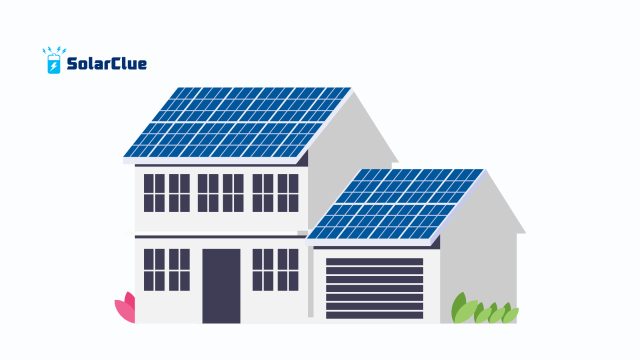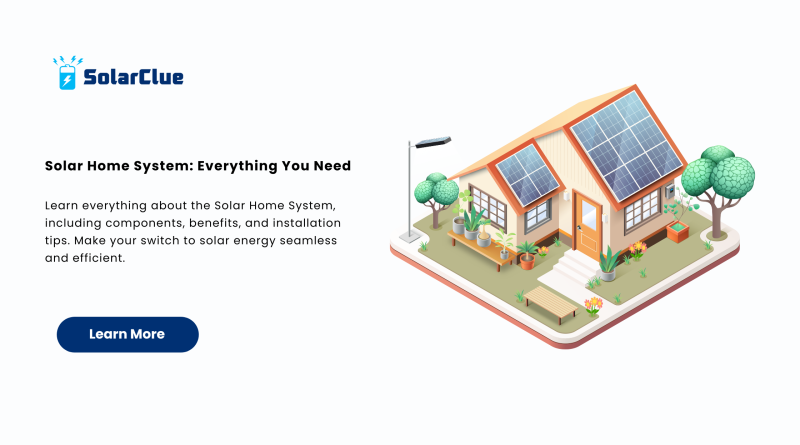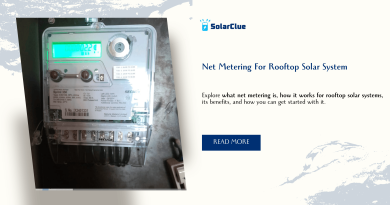Solar Home System: Everything You Need
As more homeowners turn toward renewable energy, the Solar Home System has gained significant popularity for its affordability, efficiency, and sustainability. From cutting electricity bills to powering remote locations, a home solar power system is a practical investment with long-term benefits. In this comprehensive guide, we’ll explore everything you need to know about installing and managing a solar system for your home.
Table of Contents
- 1 What is a Solar Home System?
- 2 Key Components of a Solar Home System
- 3 Benefits of Installing a Solar Home System
- 4 Types of Solar Power Systems for Homes
- 5 How to Choose the Right Solar System
- 6 Installation Process
- 7 Maintenance Tips
- 8 Government Subsidies and Incentives
- 9 Cost and ROI of Solar Home System
- 10 Common Myths About Solar
- 11 How to Monitor Your Solar System
- 12 Top Brands Offering Solar Home Systems in India
- 13 Safety Precautions
- 14 Future Trends in Residential Solar
- 15 FAQs
What is a Solar Home System?
A Solar Home System is an independent energy setup designed to power residential appliances using solar energy. It consists of solar panels, a battery, inverter, and charge controller. These systems are especially beneficial in areas with unreliable grid power or where homeowners wish to reduce their carbon footprint.
Key Components of a Solar Home System
1. Solar Panels
These are the primary component that converts sunlight into electricity. Choose between monocrystalline and polycrystalline panels based on efficiency, cost, and available space.
2. Battery Storage
A battery stores excess energy generated during the day, allowing your solar system to function at night or during cloudy periods. Lithium-ion batteries are the most preferred due to their lifespan and performance.
3. Inverter
This device converts direct current (DC) generated by solar panels into alternating current (AC) used by household appliances.
4. Charge Controller
It regulates the voltage and current coming from the panels to the battery to prevent overcharging and enhance battery life.
Benefits of Installing a Solar Home System
- Reduced Electricity Bills: You can save significantly on monthly bills by utilizing solar energy.
- Low Maintenance: Once installed, a solar power system requires minimal upkeep.
- Eco-Friendly: Decrease your carbon footprint with clean, renewable energy.
- Energy Independence: Be less reliant on grid power, especially in remote or rural areas.
Types of Solar Power Systems for Homes
1. Grid-Tied Solar System
These systems are connected to the local power grid and are ideal for homes in urban areas. They don’t require batteries and offer net metering benefits.
2. Off-Grid Solar System
Perfect for rural areas, this setup operates independently of the grid and requires battery storage.
3. Hybrid Solar System
This combines the benefits of both grid-tied and off-grid systems, offering flexibility and backup power during outages.
How to Choose the Right Solar System
Consider your energy needs, roof space, budget, and future plans before choosing a solar power system. Consulting a professional ensures the right configuration and maximum return on investment.
Installation Process
- Site Assessment: Professionals evaluate your roof orientation, shading, and structural integrity.
- System Design: Tailored to your household’s specific energy usage.
- Permits and Approvals: Necessary documentation is obtained before installation.
- Installation: Mounting panels, setting up inverters, and wiring.
- Testing & Activation: System is tested and connected to either the grid or backup battery.
Maintenance Tips
- Clean panels regularly to remove dust and debris.
- Inspect wiring and connections annually.
- Monitor system performance through mobile apps or control panels.
Government Subsidies and Incentives
The Indian government offers subsidies under schemes like MNRE (Ministry of New and Renewable Energy), reducing the upfront cost of installing a Solar Home System. States may also have individual policies supporting residential solar adoption.
Cost and ROI of Solar Home System

Initial investment varies depending on system size and type. However, most users recover their investment within 5–7 years through energy savings, making it a financially sound decision.
Common Myths About Solar
- Solar doesn’t work in cloudy weather: Modern solar systems are efficient enough to work even on overcast days.
- Too expensive: With subsidies and falling prices, solar has become affordable for the average homeowner.
- Difficult to maintain: In reality, maintenance is minimal and straightforward.
How to Monitor Your Solar System
Use IoT-based apps or online dashboards provided by system installers to track real-time energy production, usage, and efficiency.
Top Brands Offering Solar Home Systems in India
Some of the best brands include Luminous, Tata Power Solar, Loom Solar, and Microtek. They offer durable and high-efficiency solar solutions tailored for Indian conditions.
Safety Precautions
- Always hire certified installers.
- Use branded and tested components.
- Install lightning arresters if you live in a high-storm area.
Future Trends in Residential Solar
- Integration with smart home technology.
- AI-driven energy optimization.
- Greater adoption of solar + storage solutions.
Switching to a Solar Home System is more than just an eco-conscious choice—it’s a step toward energy independence, sustainability, and smart living. If you’re ready to embrace the power of the sun, now is the best time to do it.
For detailed guides, tools, and the latest solar trends, explore SolarClue and dive into expert articles on blog.solarclue.com.
Experience the sun-powered transformation—visit our website today and let your home shine with solar brilliance!
FAQs
1. How much does a Solar Home System cost in India?
Costs vary based on size and components but typically range from ₹50,000 to ₹3,00,000 after subsidies.
2. Can I power my entire home with solar energy?
Yes, depending on your setup and daily energy needs, you can go fully off-grid.
3. How long does a solar system last?
With proper maintenance, a solar power system can last 25 years or more.
4. Is it possible to upgrade my solar system later?
Absolutely. You can add more panels, batteries, or upgrade inverters as needed.
5. Will a solar system work during a power outage?
Only off-grid or hybrid systems with batteries can supply power during outages.
Let your roof do more than provide shelter—make it a source of clean, green energy. Head over to solarclue.com and blog.solarclue.com to begin your solar journey today!



